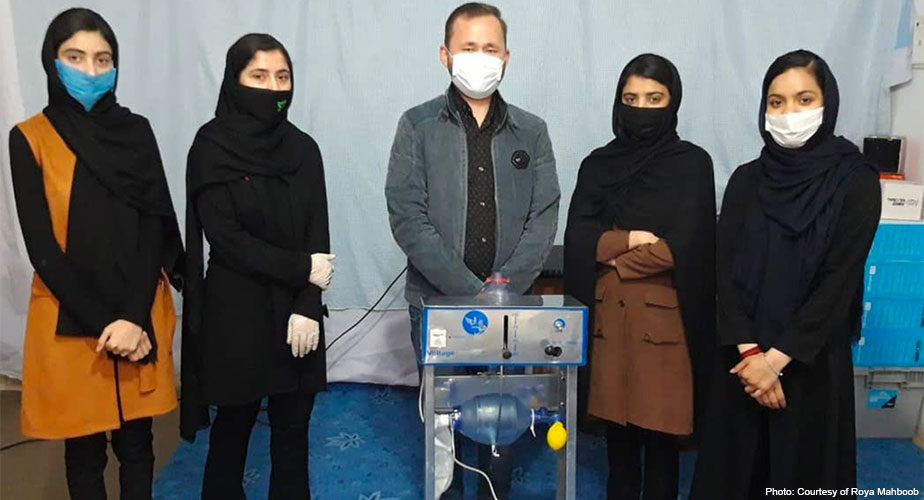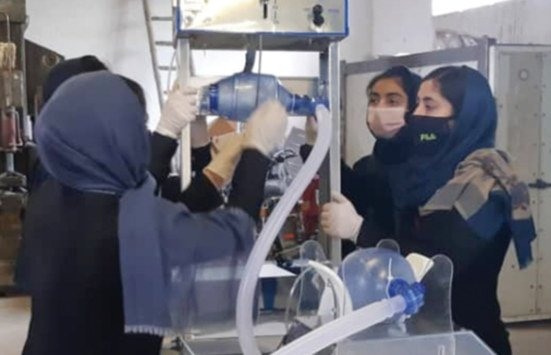The Afghan Girls’ Robotics Team Designed an Inexpensive Ventilator Out of Car Parts to Help With the Pandemic Fight
 The Afghan girls’ robotics team has joined the fight against coronavirus by designing an inexpensive ventilator out of automobile parts! The team members from Herat created the prototype after the governor of the Afghan province sent out a public plea for ventilators. The region is expecting an explosion in coronavirus cases due to a huge surge in Afghan migrant workers returning to the country from neighboring Iran, one of the disease's global hotspots. The impoverished nation is ill-prepared for any significant outbreak; as of April 2, the country's two hospitals designated for coronavirus cases had only 12 working ventilators between them. In response to this desperate need, the Afghan Dreamers robotics team developed a ventilator prototype which costs under $300 to make from parts that can be easily sourced in the country. "The only thing that we all want to do is help our people and our community," says tech entrepreneur Roya Mahboob, who founded the Afghan Dreamers program. "I work with the girls, but mostly to coordinate. They are the real heroes."
The Afghan girls’ robotics team has joined the fight against coronavirus by designing an inexpensive ventilator out of automobile parts! The team members from Herat created the prototype after the governor of the Afghan province sent out a public plea for ventilators. The region is expecting an explosion in coronavirus cases due to a huge surge in Afghan migrant workers returning to the country from neighboring Iran, one of the disease's global hotspots. The impoverished nation is ill-prepared for any significant outbreak; as of April 2, the country's two hospitals designated for coronavirus cases had only 12 working ventilators between them. In response to this desperate need, the Afghan Dreamers robotics team developed a ventilator prototype which costs under $300 to make from parts that can be easily sourced in the country. "The only thing that we all want to do is help our people and our community," says tech entrepreneur Roya Mahboob, who founded the Afghan Dreamers program. "I work with the girls, but mostly to coordinate. They are the real heroes."
Founded to encourage support for girls' education in a country where 85% of the 3.5 million children are out of school are girls, the Afghan Dreamers made headlines around the world in 2017 after they were denied U.S. visas to attend the First Global robotics competition in Washington. After an international outcry, their visas were approved and the girls ended up winning a silver medal for “courageous achievement” at the global competition. While that group of girls have now graduated, there are currently 50 Dreamers in the highly selective program, all between the ages of 14 and 17.

The program encourages local Dreamers teams to use their know-how and creativity to develop projects that can help their communities, so the team in Herat immediately focused on how they could help Afghanistan prepare for the pandemic. The team, which is made up of captain Somaya Faruqi, Dyana Wahbzadeh, Folernace Poya, Ellaham Mansori and Nahid Rahimi, decided to create a prototype that could mechanically squeeze an Ambu bag, a plastic pouch with a mask that's normally used by hand to help patients breathe. Whatever they designed would need to be able to squeeze the bag rhythmically, be adjustable for pressure and speed, and be able to run for long periods of time. With the country often experiencing power shortages, they also aim to make it able to operate on back-up battery or solar power if necessary.
At first, they tried to build an advanced digital ventilator but it was difficult to source the parts needed from overseas and the costs were prohibitive. Instead, the group decided to modify a design from the Massachusetts Institute of Technology using local parts from Toyota Corolla cars which are readily available locally. They developed a prototype and sent the design to experts at MIT for their feedback.
“We discussed our design with a professor from MIT, and sent it, based on the MIT prototype, using Toyota Corolla parts. He (the professor) was so surprised and wrote back to us saying that it was a clever design but would need to see if the system worked," Mahboob explains. “What we are hoping, is that with the help of MIT we will be able to improve our model and make it ready for actual use by the end of May or June."
The added challenge the girls have encountered in developing their prototype is finding a way to meet in person while still following community guidelines designed to avoid the virus' spread. "It's very difficult for the girls to come together in one place," Mahboob says. "The shops are closed, so we have to call so many people to open the shop — someone who knows someone, who can open the store to get that part." However, the girls have persevered and hope that, after their prototype is refined, it can be put to use especially in remote clinics with limited equipment. "The idea of these machines is that we use them for emergency cases, when there are no professional ventilators," explains Mahboob. "If we don't have access to anything professional we can use these ones."
Once the prototype is finalized, it will have to be approved by the World Health Organization (WHO) and the Afghan Public Health Ministry before the team can start producing more machines, says Dr. Mehdi Hadid, a member of a medical board fighting the spread of coronavirus in Herat. The girls are optimistic that they will be able to perfect their ventilator design so it can be ready to help save lives as the outbreak spreads. For her part, Mahboob also hopes that the girls' success will show people across Afghanistan the value of educating girls: "In order to compete and prosper in the 21st century, all countries must be able to access the highest technology that's transforming our world. If these girls have access to the opportunity or the tools, their lives can be changed. But not only their lives, they can change their community, too."
The Afghan Girls’ Robotics Team Designed an Inexpensive Ventilator Out of Car Parts to Help With the Pandemic Fight
![The Afghan Girls’ Robotics Team Designed an Inexpensive Ventilator Out of Car Parts to Help With the Pandemic Fight]() Reviewed by Your Destination
on
April 16, 2020
Rating:
Reviewed by Your Destination
on
April 16, 2020
Rating:
No comments